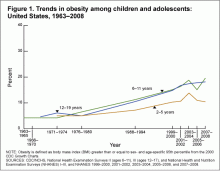
Childhood obesity is a serious health condition that occurs when a child is well above the normal weight for his age and height. The trend for increased childhood obesity rates is especially troubling, because the extra weight on children often leads to increased risk of health problems that were once primarily confined to adults.1
There are many health-related consequences of childhood obesity. Risk factors for cardiovascular disease (CVD) include high blood pressure, high cholesterol, and abnormal glucose tolerance. A sample of children aged 5-17 showed 70% of obese children had at least one CVD risk factor while 39% had two or more CVD risk factors. Other health conditions associated with increased weight include Type 2 diabetes, asthma, sleep apnea, and hepatic steatosis, which is the fatty degeneration of the liver. Overweight children often are targets of social discrimination, which leads to low self-esteem that can hinder academic and social functioning and lead to depression.2 Children who are obese are also at greater risk for bone and joint problems, which could develop into osteoarthritis.3
Over the past 30 years, childhood obesity rates have tripled with nearly one in three children in America being overweight or obese. Thirty years ago most children led lives that kept them at healthy weights. They walked or rode bicycles to school, played actively at recess, participated in gym class, and played for hours after school before dinner. Meals were home-cooked with reasonable portions, and eating fast food and high calorie snacks was rare.4
Today’s children lead much different lives. They are driven to school, recess and gym classes have been reduced, and few children have the time or opportunity to engage in free play after school. Outdoor activities are replaced by TV, video games, and the internet. Families eat fewer home-cooked meals, portions sizes are two to five times larger than before, and high-calorie drinks and snacks are the norm.5 Because many parents are not setting healthy examples, it has been found that children of overweight mothers are 15 times more likely to be obese by the age of six than of lean mothers.6 These are some of the factors contributing to the increased rate of childhood obesity.
Obesity is often defined as excess body fat. To determine a person’s body fat, the person is often measured by a scientific calculation called body mass index (BMI), which measures weight in relation to height. For children, the BMI number is compared with measurements of other children who are the same age and sex, because of changes that occur during growth and development. Growth charts from the Centers for Disease Control and Prevention (CDC) are used to calculate their BMI. Although BMI is not a perfect indicator of obesity, it is commonly used as a scientific way to categorize if a child is underweight (less than 5th percentile on the growth chart), normal weight (between 5th and 85th percentiles), overweight (between 85th and 95th percentiles), or obese (higher than the 95th percentile).7
Using heights and weights of children and adolescents aged 2-19, data was compiled from the National Health and Nutrition Examination Survey (NHANES) to monitor the prevalence of obesity. Surveys done between 1976-1980 and 2007-2008 showed an increase in obesity for children aged 2-5 from 5.0% to 10.4%, for children aged 6-11 from 6.5% to 19.6%, and from adolescents aged 12-19 from 5.0% to 18.1%. There are significant disparities in obesity prevalence for racial, ethnic, and poverty level differences. The prevalence of obesity has risen significantly for Mexican-American adolescent boys (26.8%) and non-Hispanic black adolescent girls (29.2%).8
Because of the growing concern with the epidemic of childhood obesity, many programs are available seeking to bring awareness of the need for better nutrition for children as well as encouraging more physical activity. The Let’s Move! campaign, started by First Lady Michelle Obama, has set the goal of solving the challenge of childhood obesity within a generation, so that children born today will reach adulthood at a healthy weight.9 Project Fit America is a non-profit charity that donates fully funded cardiovascular health and fitness education programs to schools. The Major League Baseball Players Association has joined with the Let’s Move! campaign to publicize the message to fight childhood obesity and educate the public.10 NFL Play 60 is a campaign of the National Football League designed to get children active through in-school, after school, and team-based programs.11 The Robert Wood Johnson Foundation has committed $500 million to reach its goal to reverse the epidemic of childhood obesity in the United States by 2015.12
- 1. “Childhood obesity.” MayoClinic.com. < http://www.mayoclinic.com/health/childhood-obesity/DS00698 > 5 Nov. 2010.
- 2. “Consequences.” Centers for Disease Control and Prevention. < http://www.cdc.gov/obesity/childhood/consequences.html > 5 Nov. 2010.
- 3. “Childhood Obesity.” Healthy Youth! Centers for Disease Control and Prevention. < http://www.cdc.gov/healthyyouth/obesity/ > 5 Nov. 2010.
- 4. “Learn the Facts.” Let’s Move! < http://www.letsmove.gov/learnthefacts.php > 4 Nov. 2010.
- 5. Ibid.
- 6. “Quick Facts.” Active Living Network. < http://www.activeliving.org/resources/quickfacts > 30 Aug. 2010.
- 7. “Getting Started: What is Obesity?” Let’s Move! < http://www.letsmove.gov/healthyweight.php > 4 Nov. 2010.
- 8. Ogden, Cynthia and Margaret Carroll. “Prevalence of Obesity Among Children and Adolescents: United States, Trends 1963-1965 Through 2007-2008.” Centers for Disease Control and Prevention. < http://www.cdc.gov/nchs/data/hestat/obesity_child_07_08/obesity_child_07_08.htm > 4 Nov. 2010.
- 9. “Learn the Facts.” Let’s Move! < http://www.letsmove.gov/learnthefacts.php > 5 Aug. 2010.
- 10. “Who We Are.” Project Fit America. < http://www.projectfitamerica.org/who_are_we.html > 5 Aug. 2010.
- 11. “NFL Play 60: The NFL Movement For An Active Generation.” National Football League. < http://www.nfl.com/news/story?id=09000d5d80b4a489&template=with-video&confirm=true > 5 Aug. 2010.
- 12. “Arkansas leading national effort to fight fat in kids.” Texarkana Gazette. 18 Jan. 2010. < http://www.texarkanagazette.com/news/WireHeadlines/2010/01/18/Arkansas-leading-national-effort-to-figh-56.php > 19 Jan. 2010.

